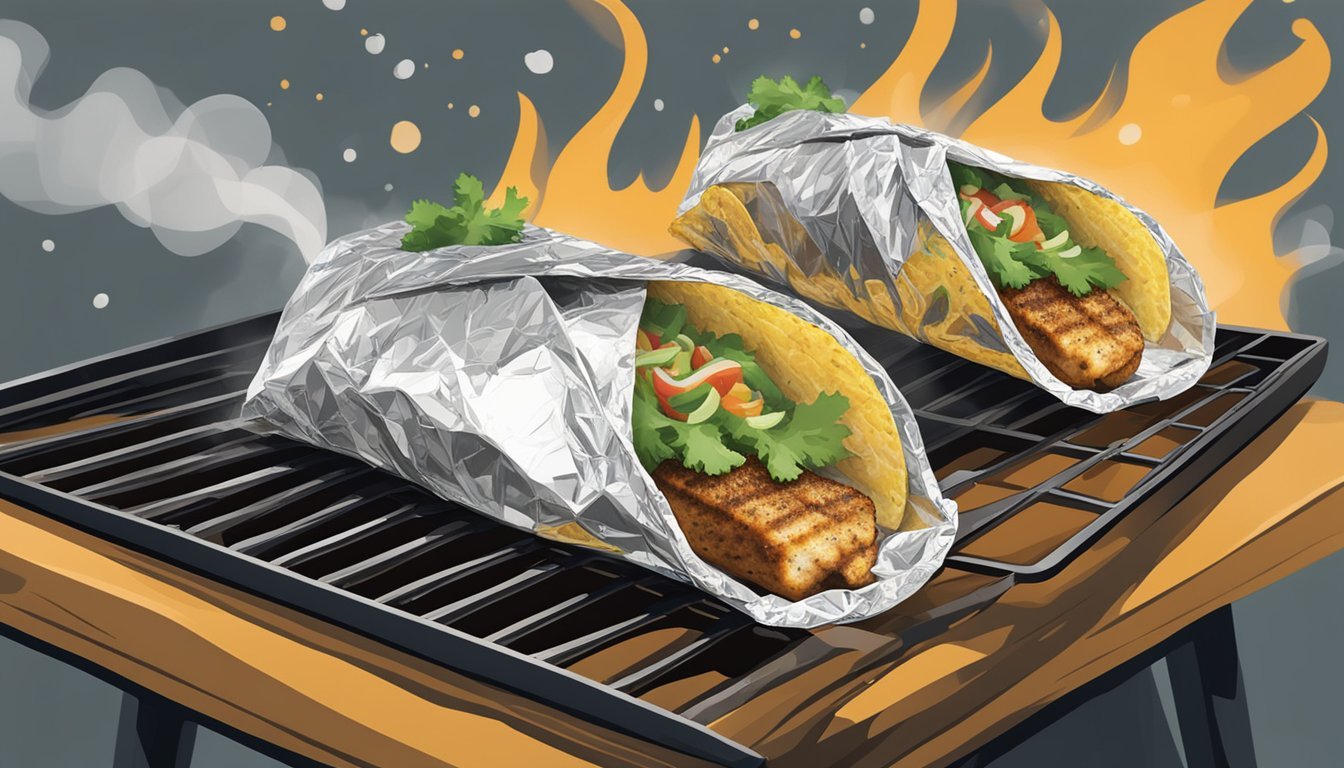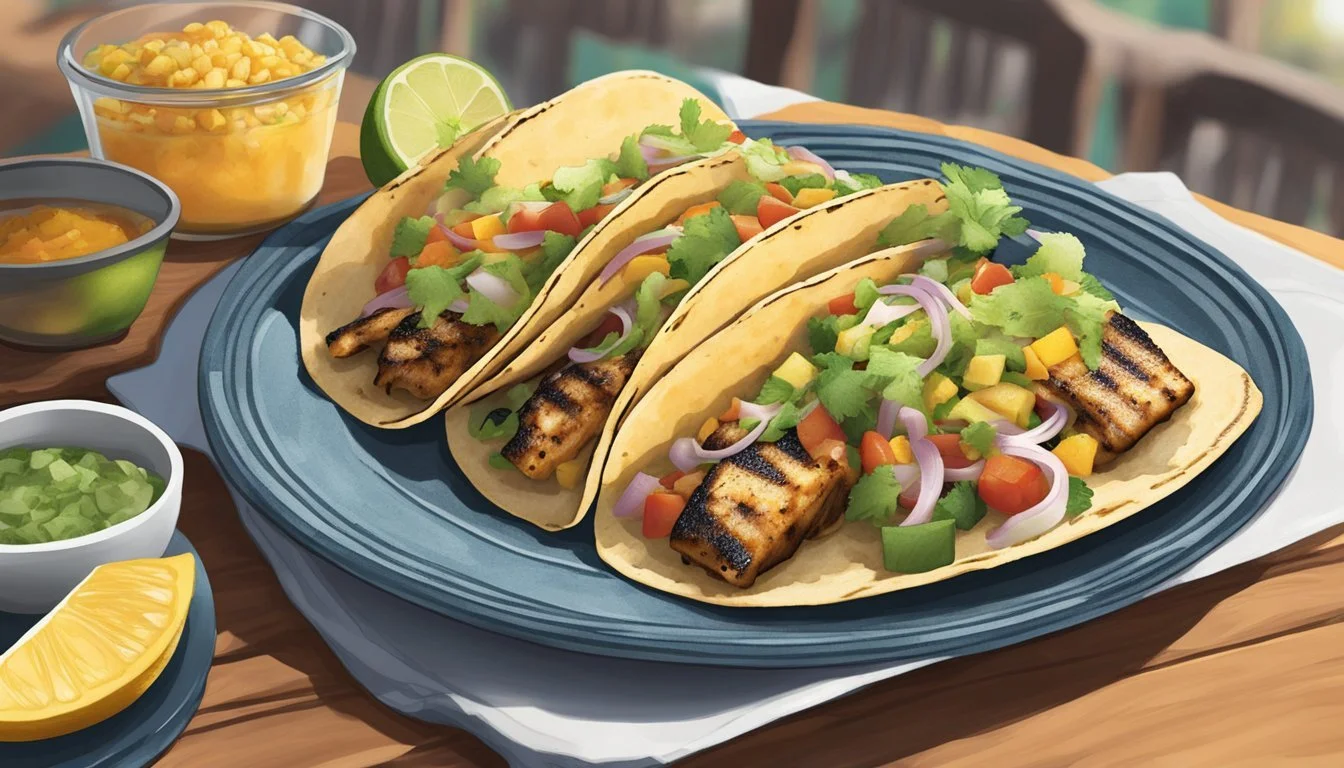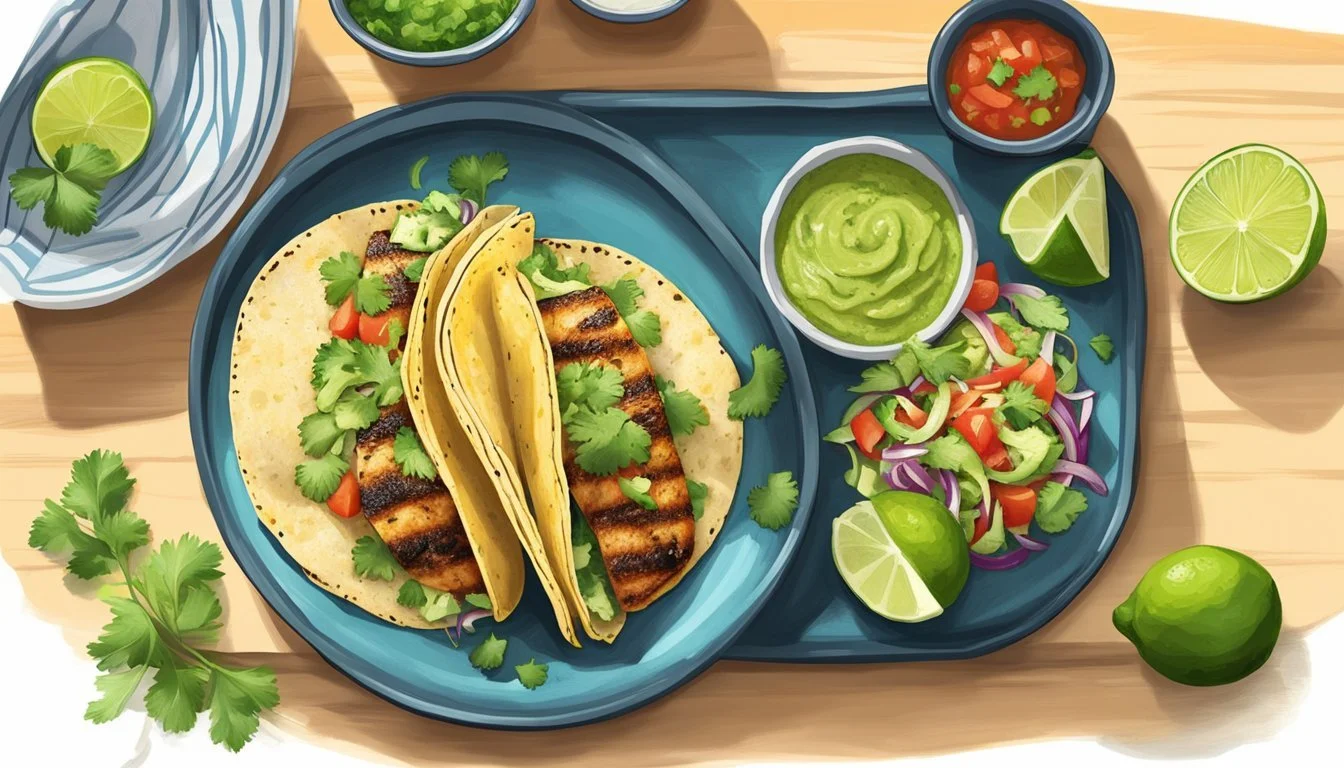Best Way to Reheat Grilled Mahi-Mahi Tacos While Preserving That Perfect Smokiness
Reheating grilled Mahi-Mahi tacos presents a challenge for both home cooks and culinary professionals alike. The goal is to maintain the delicate texture and distinct smoky flavor that make these fish (What wine goes well with fish?) tacos a delightful meal. Preserving the quality and taste of the Mahi-Mahi during reheating requires careful attention to method and timing. Utilizing the best practices not only guarantees the sustenance of the fish's natural juices but also its signature grilled essence.
For the best results, using a skillet is highly recommended. It provides control over the heat and allows for a gentle reheating process. The use of a little butter or oil aids in preventing sticking, while a splash of water introduced into the pan helps to reintroduce moisture. Heating each side briefly ensures the fish warms through without becoming dry. It's a delicate balance to strike, aiming to awaken the spices and smoky aroma inherent from the initial grilling without overcooking the Mahi-Mahi.
Choosing the right method for reheating not only revives the fish's firm yet flaky texture but also enhances its flavors, bringing the Mahi-Mahi tacos back to life. Whether preparing for a quick meal or serving guests, the experience of savoring successfully reheated tacos is akin to enjoying them freshly grilled. The key is in preserving what made them exceptional in the first place—their unmistakable smoky flavor and ideally cooked fish, nestled in a soft taco, ready to be enjoyed once more.
Understanding Mahi Mahi
Before diving into the best ways to reheat grilled Mahi-Mahi tacos to retain their smoky flavor, it's important to have a basic understanding of Mahi-Mahi itself. Knowing about its characteristics and nutritional content can ensure that the reheating process preserves the fish's quality and health benefits.
Characteristics of Mahi Mahi
Mahi-Mahi, also known as dolphinfish, is a white fish known for its firm texture and mild, sweet flavor profile. It boasts a beautiful, iridescent skin that is typically removed before cooking. This fish's firmness makes it an excellent candidate for grilling, as it maintains its integrity during cooking and reheating. Generally, Mahi-Mahi fillets have a moderate amount of fat, which contributes to their ability to stay moist and flavorful when cooked properly.
Health Benefits and Nutritional Value
The nutritional value of Mahi-Mahi is quite impressive. Here's a brief overview of what a 3-ounce (85-gram) serving of cooked Mahi-Mahi typically provides:
Nutrients Amount Calories 93 kcal Protein 20.2 g Fat 0.7 g Saturated Fat 0.2 g
Mahi-Mahi is a lean source of high-quality protein and low in saturated fat. It contains essential vitamins and minerals, making it a nutritious option for a balanced meal. Furthermore, due to its low calorie content, it is a great choice for those who are watching their caloric intake.
Initial Preparation and Cooking
Preparing and cooking Mahi Mahi for grilled fish tacos involves a careful approach to seasoning and grilling. Selecting the right ingredients and following precise cooking techniques are essential to achieve the ideal flavor and texture crucial for making the dish stand out.
Seasoning the Mahi Mahi
Before grilling, ensure the Mahi Mahi filets are patted dry to maximize the adherence of the seasoning. A balanced spice mixture provides the foundation for flavorful fish tacos. Here is a suggested blend:
1 teaspoon of kosher salt
1 teaspoon of garlic powder
1/2 teaspoon of paprika
Freshly ground black pepper to taste
Optional: Chopped cilantro for an aromatic finish
Combine these ingredients in a small bowl. Brush each Mahi Mahi filet with olive oil on both sides to promote an even crust. Sprinkle the blended seasonings onto the filets, ensuring full coverage for a uniformly seasoned taste.
Grilling Techniques
Preheat the grill to medium-high heat, which typically ranges between 375-450°F (191-232°C). This temperature allows for a gentle char that doesn't overcook the delicate Mahi Mahi. Ensure the grill grates are clean and brushed with oil or coated with cooking spray to prevent sticking.
For the grilling:
Place Mahi Mahi filets on the hot grill.
Cook for 3-5 minutes before flipping to the other side.
Grill for an additional 3-5 minutes.
The fish should be opaque and flaky when done. Alternative fish options like snapper, halibut, or cod can be used with similar cooking times adjusted for thickness. Grilled accurately, Mahi Mahi maintains a smoky, juicy quality that makes for a perfect fish taco.
Storing and Preserving Grilled Mahi Mahi Tacos
Proper storage of grilled Mahi Mahi tacos is essential to maintain their quality and flavor. Ensuring leftovers are handled correctly can significantly extend their life while preserving their smoky essence.
Best Practices for Storage
Immediate Cooling: Cool the grilled Mahi Mahi to room temperature before storage to prevent moisture buildup that could lead to sogginess and bacteria growth.
Airtight Containers: Store the Mahi Mahi in airtight containers to protect it from air exposure, which can dry it out and cause it to absorb unwanted odors from the refrigerator.
Separate Components: For the best quality, store the fish, tortillas, and toppings separately. Toppings and tortillas can be kept refrigerated in plastic wrap or sealed bags to maintain freshness.
Freezing and Thawing Methods
Wrapping for Freezing:
Wrap the grilled Mahi Mahi tightly in plastic wrap or aluminum foil to protect against freezer burn.
Place the wrapped fish in a heavy-duty freezer bag, pressing out as much air as possible before sealing.
Thaw the frozen Mahi Mahi in the refrigerator overnight to ensure even and safe reheating.
Avoid thawing fish at room temperature as it can lead to moisture loss and potential bacterial growth.
Reheating for Optimal Taste and Texture
When reheating grilled Mahi-Mahi tacos, maintaining the fish's original flakiness and the smoky flavor can be a challenge. Selecting the proper reheating method and following specific steps can preserve both the taste and texture of this delicate dish.
Choosing the Right Reheating Method
The key to perfectly reheated Mahi-Mahi tacos lies in the method chosen. A conventional oven is often preferred for its even heating, which helps retain texture. Wrapping the fish in foil can trap moisture, preventing dryness. An alternative is using a non-stick skillet over medium heat for a quick sear that won't compromise the fish’s flakiness. Both methods avoid the common pitfalls of microwave reheating, which can unevenly heat and rubberize the fish.
Step-by-Step Reheating Instructions
Oven Reheating:
Preheat the oven to 275°F (135°C).
Wrap Mahi-Mahi tacos (remove any cream or cold toppings) in aluminum foil to guard against dryness.
Heat for approximately 10-15 minutes, or until the internal temperature reaches 145°F.
Season with black pepper after reheating to enhance flavor.
Skillet Reheating:
Heat a non-stick skillet over medium heat.
Add a touch of oil or butter to the hot pan to prevent sticking.
Gently reheat Mahi-Mahi for 2-3 minutes per side, adding a tablespoon of water if necessary to retain moisture.
Ensure the fish reaches the recommended internal temperature before serving.
By carefully following these instructions, the Mahi-Mahi in the tacos can be revitalized, making them just as enjoyable as when they were first grilled.
Accompaniments and Toppings
Choosing the right accompaniments and toppings for grilled Mahi-Mahi tacos is crucial in enhancing the dish's flavors and textures. A balance of citrusy, spicy, and fresh ingredients brings out the best in the smoky fish.
Selecting Complementary Flavors
Grilled Mahi-Mahi, also known as dorado, has a distinct smoky flavor that pairs exceptionally well with fresh and bright ingredients. A well-constructed taco should strike a harmony between the richness of the fish and the zest of the toppings.
Citrus: A drizzle of lime or lemon juice adds a bright note that complements the smoky mahi-mahi. Their zest can uplift the overall flavor profile.
Salsa: Salsas like mango salsa, pico de gallo, or a simple combination of tomato, onion, and cilantro provide a fruity or herbal accent.
Spice: For heat, options include cayenne pepper or a splash of hot sauce to taste.
Creaminess: Avocado, homemade guacamole, sour cream, or a seasoned crema can balance the heat and add a creamy texture.
Herbs: Fresh cilantro or a pinch of oregano offer a finishing herbaceous touch.
Garnish: Serve with a lime wedge to be squeezed over the taco for an extra punch of flavor.
Homemade Toppings Recipes
Creating homemade toppings allows for customization of flavors to suit the Mahi-Mahi's natural taste.
1 mango, diced
1/4 cup finely chopped red onion
Juice of 1 lime
1 tablespoon chopped cilantro
Salt and pepper to taste
Mix all ingredients in a bowl and let sit for 10 minutes for flavors to meld.
Cabbage Slaw:
2 cups shredded cabbage
1/4 cup lime juice
1/2 teaspoon onion powder
Salt and a dash of cayenne pepper
Combine in a bowl and refrigerate for at least 30 minutes before serving.
For the tacos themselves, one can choose between corn or flour tortillas, warmed slightly on the grill to keep them pliable. Mahi-Mahi fish tacos are typically served in groupings, usually as two to three servings, depending on the size of the tortillas and the amount of toppings used. The key is to layer the flavors without overwhelming the delicate taste of the mahi mahi fillets.
Alternative Reheating Methods
When reheating grilled Mahi-Mahi tacos, maintaining the original flavor and texture is paramount. These alternative methods focus on preserving the smokiness while ensuring the fish remains moist or achieves a desirable crispness.
Using a Steamer for Moisture Retention
For those desiring to keep their Mahi-Mahi tacos moist, particularly the fish itself, steaming is an excellent method. A steamer can gently warm the fish without drying it out. One should add a bit of soy sauce or a similar liquid in the steamer's water to infuse the fish with additional flavor, mimicking the juiciness of the original dish. The process is straightforward:
Fill the steamer with water and add 1 tablespoon of soy sauce.
Place the Mahi-Mahi inside the steamer basket, ensuring it's not overcrowded.
Cover and steam for 2-3 minutes or until heated through.
Broiling for a Crisp Texture
If a crispier edge to the Mahi-Mahi is desired, reminiscent of the original grilling, broiling is the method of choice. The intense, direct heat from the broiler can mimic the taco's initial crispy texture, but careful monitoring is essential to avoid overcooking. The steps are as follows:
Preheat the broiler to high and position the rack so that the fish is near the heat source.
Place fish on a baking sheet lined with foil and lightly coated with oil.
Broil the Mahi-Mahi for 1-2 minutes each side or until the desired crispness is achieved.
One should not use these methods for reheating accompaniments like pasta, as they require different treatment for optimal reheating.
Dishes to Serve with Mahi Mahi Tacos
When crafting the perfect meal with Mahi Mahi tacos, one must consider the balance of flavors and textures to complement the tacos' smoky taste and satisfying fill.
Suggested Side Dishes
Rice: A bowl of cilantro lime rice can offer a refreshing and tangy contrast to the tacos' richness.
Beans: Black beans simmered with spices are an excellent choice for adding creamy and hearty elements.
Salads:
A cabbage slaw dressed in a light vinaigrette can provide a crunchy texture.
A simple green salad with a citrusy dressing will add a crisp freshness to balance the meal.
Vegetables:
Grilled corn on the cob encourages a smoky flavor that resonates with that of the grilled Mahi Mahi.
Roasted zucchini lightens the plate with its subtle sweetness.
Cheese:
Queso fresco or cotija cheese sprinkled over the sides can enhance them with a salty, milky touch.
Pairing with Drinks and Beverages
For non-alcoholic options, the crispness of iced tea or sparkling water with lime cuts through the tacos' richness.
Alcoholic Pairings:
Light beer: A cold, light beer complements the tacos without overpowering them.
White wine: A glass of crisp, acidic white wine like Sauvignon Blanc pairs well.
The choice of sides and beverages should be guided by complementing the Mahi Mahi tacos' taste, ensuring a delightful and harmonious meal experience.
Food Safety and Best Practices
When reheating grilled Mahi-Mahi tacos, one must not only aim to preserve the smoky flavor but also ensure the process adheres to food safety protocols. Proper temperature control and hygienic practices are paramount.
Ensuring Proper Internal Temperature
It is critical to reheat Mahi-Mahi to an internal temperature of 145°F to ensure it is safe for consumption. Using a food thermometer:
Check the temperature at the thickest part of the Mahi-Mahi.
Avoid touching the bone if present, as this can give a false reading.
Tips to Avoid Cross-Contamination
To prevent cross-contamination, one must be vigilant:
Use separate utensils for raw and cooked foods.
The board or surface where the Mahi-Mahi is placed should be clean and sanitized prior to use.
Always wash hands thoroughly before and after handling the fish.





